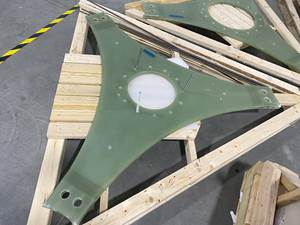High Performance Composites magazine's Editorial page
As I write this, the Olympics are at the halfway mark, the U.S. stock market has edged up just over 10,000, oil prices have dropped to $46 a barrel and the standoff in Iraq is coming to a head. It feels like the whole world is teetering at the edge, and we all have hope in our hearts and have our fingers crossed. If
As I write this, the Olympics are at the halfway mark, the U.S. stock market has edged up just over 10,000, oil prices have dropped to $46 a barrel and the standoff in Iraq is coming to a head. It feels like the whole world is teetering at the edge, and we all have hope in our hearts and have our fingers crossed. If we can just make it through the next few days ... months ... without a terrorist-related catastrophe, we can handle anything else.
Unfortunately, regardless of how the immediate situation plays out, the oil shortage will not go away. Although the reality is somewhere between T. Boone Pickens' recent prognostication -- that worldwide oil production capacity will peak around 2008 -- and the optimists' projections of 40 years of unhampered growth, we all know we are dealing with a finite quantity. The growth curve in developing countries alone -- China and India, in particular -- will ensure that we meet our day of reckoning on oil sooner than we have anticipated.
We in composites are directly affected by high oil prices in more ways than most industries. Polymer resin is made from oil, and manufacturing both resins and fiber is energy intensive, pushing up the electric/gas bill. For the last decade, serious consideration has been given to developing alternative energy sources. Fortunately, many of the emerging solutions to the global oil problem will bring abundant benefit to the composites industry. Many use composite materials in a major way. Wind turbines, for example, are already commercially available. Others, such as hydrogen fuel, tidal turbines and wave-actuated power generators require further development to make them truly mainstream. Major companies are pouring R&D dollars into these projects, and high-priced oil/gas should accelerate the pace of development. In addition, governments are looking for ways to help alternative energy sources become commercially viable, faster.
With that in mind, we will publish in December our COMPOSITES IN ALTERNATIVE ENERGY: A Design and Application Guide. This publication will be sent to appropriate individuals in the composites industry and to around 8,000 decisionmakers who design, evaluate and purchase power systems, including key global government personnel.
We in the industry know that good design, new and improved manufacturing technology and better materials have made composite products dependable and less expensive. In many applications, composites are not only the best material but also the most cost-effective. The Guide will explain the technical benefits of composite materials to individuals who may not know much about composites and also may be skeptical, based on the little they do know. This is an opportunity to do some pioneering for composite materials. We are writing the Guide now. If you would like to contribute technical or market information to this effort, please contact me (judy@compositesworld.com) or the Guide's project editor, Sara Black (sara@compositesworld.com). Industry suppliers interested in sponsoring the Guide should contact our global sales manager, Dirk Weed (dirk@compositesworld.com). For direct phone contact, dial (303) 467-1776).
Speaking of writing, we just had our annual Editorial Meeting, and the 2005 editorial calender will be published at our Web site in mid-September (www.compositesworld.com). Your contributions are sought here, as well. We're also looking for a senior writer (contact our managing editor, Mike Musselman, mike@compositesworld.com). Composites design and manufacturing experience is required. (We've decided it's a lot easier to teach a composites professional how to write to our style than to teach a professional writer about composites.) Give us a call if you're interested.
As this goes to press, I'm on my way to Shanghai for the China Composites Show - and I'm keeping my fingers crossed.
Related Content
Drag-based wind turbine design for higher energy capture
Claiming significantly higher power generation capacity than traditional blades, Xenecore aims to scale up its current monocoque, fan-shaped wind blades, made via compression molded carbon fiber/epoxy with I-beam ribs and microsphere structural foam.
Read MoreComposites end markets: Batteries and fuel cells (2024)
As the number of battery and fuel cell electric vehicles (EVs) grows, so do the opportunities for composites in battery enclosures and components for fuel cells.
Read MoreRTM, dry braided fabric enable faster, cost-effective manufacture for hydrokinetic turbine components
Switching from prepreg to RTM led to significant time and cost savings for the manufacture of fiberglass struts and complex carbon fiber composite foils that power ORPC’s RivGen systems.
Read MoreCollins Aerospace to lead COCOLIH2T project
Project for thermoplastic composite liquid hydrogen tanks aims for two demonstrators and TRL 4 by 2025.
Read MoreRead Next
“Structured air” TPS safeguards composite structures
Powered by an 85% air/15% pure polyimide aerogel, Blueshift’s novel material system protects structures during transient thermal events from -200°C to beyond 2400°C for rockets, battery boxes and more.
Read MorePlant tour: Daher Shap’in TechCenter and composites production plant, Saint-Aignan-de-Grandlieu, France
Co-located R&D and production advance OOA thermosets, thermoplastics, welding, recycling and digital technologies for faster processing and certification of lighter, more sustainable composites.
Read MoreVIDEO: High-volume processing for fiberglass components
Cannon Ergos, a company specializing in high-ton presses and equipment for composites fabrication and plastics processing, displayed automotive and industrial components at CAMX 2024.
Read More








.jpg;maxWidth=300;quality=90)












